St Brigid's College is an independent Roman Catholic co-educational primary and single-sex secondary day and boarding school for girls, located in Lesmurdie, a suburb of Perth, Western Australia.
Mgr Anselm Bourke, born Nicholas Bourke, was a Roman Catholic priest of Irish origins. He was prominent in Catholic education for several decades, and also founded the West Perth parish of the Church in 1901. He made his profession as a Benedictine monk in 1858, but got dispensation from his monastic vows from the Vatican in 1871; therefore, he cannot be called a Benedictine.

Stirling Terrace is the main street of Toodyay, Western Australia, originally called New Road until 1905.
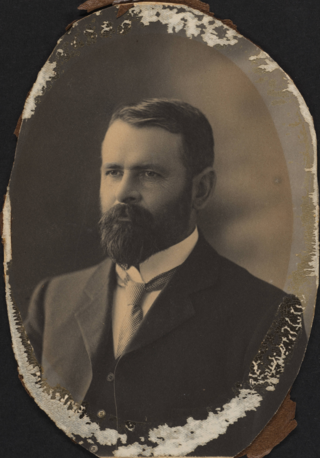
Michael Francis Cavanagh was an Australian architect, primarily known for his work in Western Australia from 1895 to the late 1930s.
The Roman Catholic Church Group, Toodyay is a site on Stirling Terrace in Toodyay, Western Australia, owned by the Catholic Church. This site was registered as Roman Catholic land in November 1861 in the newly proclaimed Avon District town of Newcastle. These buildings were erected here between the early 1860s and 1963:
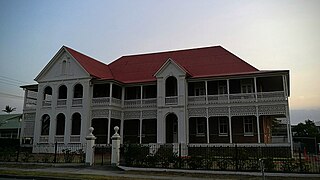
Mount Carmel Convent is a heritage-listed Roman Catholic former convent at 199 Bay Terrace, Wynnum, City of Brisbane, Queensland, Australia. It was designed by Hall & Dods and built in 1915 by William Richard Juster. It was added to the Queensland Heritage Register on 27 August 1999.

St Brigid's Convent is a heritage-listed former Roman Catholic convent at 9-17 Upper Clifton Terrace, Red Hill, City of Brisbane, Queensland, Australia. It was designed by Eaton & Bates and built from 1902 to 1923. It was also known as Convent of the Annunciation and Red Hill Convent. It was added to the Queensland Heritage Register on 28 March 2003.

St Francis Xavier Church is a heritage-listed Roman Catholic church at 6 Church Street, Goodna, City of Ipswich, Queensland, Australia. It was designed by Andrea Giovanni Stombuco and built in 1881 by William Hanley. It was originally known as St Patrick's Church. It was added to the Queensland Heritage Register on 21 October 1992.

St Mary's Church is a heritage-listed Roman Catholic church precinct at Mary Street, Woodend, Ipswich, City of Ipswich, Queensland, Australia. It was built from 1874 to 1970s. It is also known as the former St Brigids Convent. It was added to the Queensland Heritage Register on 21 October 1992.
Angela Browne was born in County Cork, Ireland in 1884. She would later become Mother Superior at the Sisters of Mercy Convent in Toodyay, Western Australia.

Our Lady Star of the Sea Church & School is a heritage-listed Roman Catholic church and school at Goondoon Street, Gladstone, Gladstone Region, Queensland, Australia. It was built from 1924 to 1950. It was added to the Queensland Heritage Register on 21 October 1992.

St Mary's Church and Convent are heritage-listed Roman Catholic church buildings at 34 Ingham Road, West End, City of Townsville, Queensland, Australia. It was designed by the Rooney Brothers and built by Cowell & Holt in 1888. It was added to the Queensland Heritage Register on 2 January 1993.

St Patrick's Convent is a heritage-listed Roman Catholic convent at 45 The Strand, North Ward, City of Townsville, Queensland, Australia. It was built in c. 1883. It was added to the Queensland Heritage Register on 3 February 2012.

St Brigid's Church is a heritage-listed Roman Catholic church at 523 Stuart Drive, Stuart, City of Townsville, Queensland, Australia. It was built in 1904. It was added to the Queensland Heritage Register on 21 October 1992.
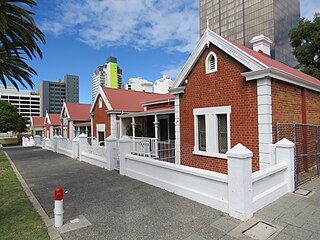
Victoria Square is the name of the area and road that runs around the edge of the grounds of St Mary's Cathedral in Perth, Western Australia.

St Joseph's Convent is a heritage-listed convent at 179 Abbott Street, Cairns City, Cairns, Cairns Region, Queensland, Australia. It was designed by Edward Gregory Waters and built from 1912 to 1914 by Wilson & Baillie. It was added to the Queensland Heritage Register on 1 July 1997.
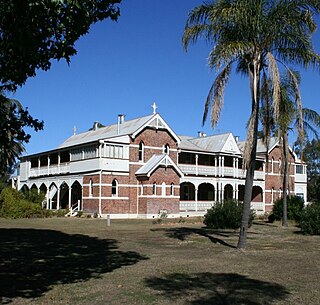
St Columba's Convent is a heritage-listed Roman Catholic former convent at 169 Cunningham Street, Dalby, Western Downs Region, Queensland, Australia. It was designed by George Bernard Roskell and built in 1913 by John Draney. It is also known as Iona. It was added to the Queensland Heritage Register on 9 December 2010.

All Hallows' School Buildings are a heritage-listed group of Roman Catholic private school buildings at 547 Ann Street, Fortitude Valley, City of Brisbane, Queensland, Australia. They were designed by a number of notable Brisbane architects and were constructed over many years. The earliest is the All Hallows Convent, also known as Adderton. The buildings were added to the Queensland Heritage Register on 21 October 1992.

St Brigid's Roman Catholic Church is a heritage-listed Roman Catholic church building located at 14, 16 Kent Street, in the inner city Sydney suburb of Millers Point, New South Wales, Australia. It is also known as St. Brigid's Roman Catholic Church & School, St Brigid's, and St Bridget's. The property is owned by Saint Brigid's Roman Catholic Church. It was added to the New South Wales State Heritage Register on 2 April 1999.
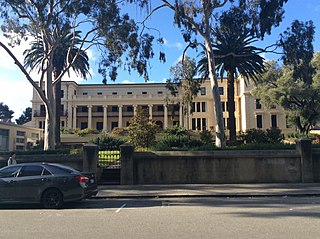
Archbishop's Palace is a heritage-listed building in Perth, Western Australia, used by bishops and archbishops of Perth since 1855. In addition to the cultural value to the Roman Catholic community, the palace is a good example of architect Michael Cavanagh's Federation Academic Classical style, and a prominent landmark within the Victoria Square precinct. It is also known as the Catholic Church Office, and Roman Catholic Presbytery.



















